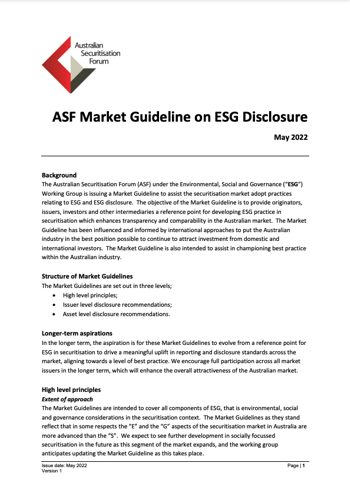
ESG guidelines for the securitisation sector
A reference point for originators, issuers, investors and other intermediaries in developing environmental, social and governance (ESG) practices in securitisation, enhancing transparency and comparability in the Australian market.
As a specialist investor in emissions reduction, the CEFC has played a leading role in the market development and issuance of climate or green fixed income products in Australia – with substantial investments in securitisation funding across the auto, personal loan and home mortgage sectors.
About the guidelines
ASF Market Guideline on ESG Disclosure
May 2022
The Market Guideline was developed by a working group convened by the Australian Securitisation Forum (ASF), the leading industry body representing participants in the securitisation and covered bond markets.
Read moreThe Market Guideline is intended to assist in championing best practice within the Australian industry. In the longer term, the aspiration is for these Market Guidelines to evolve from a reference point for ESG in securitisation to drive a meaningful uplift in reporting and disclosure standards across the market, aligning towards a level of best practice.
about the industry
The ASF working group brings together issuers, investors and other market participants with the common goal of advancing the market’s approach to environmental, social and governance (ESG) considerations. The timeliness of this initiative has been borne out by the continued rapid penetration of ESG concerns into all aspects of investors’ and issuers’ businesses.
The objective of the working group has been to issue for feedback a set of market guidelines to act as a reference point for developing ESG practice in securitisation, and to enhance transparency and comparability in Australia. It took into account international developments to put the Australian industry in the best possible position to attract support from international investors focused on ESG.
The output of the working group includes a description of the high level principles of the market guidelines and a detailed set of recommendations for issuers of any transaction. This provides an ESG framework for all deals, including those where no specific claims are being made about ESG-positive outcomes.
There are also proposed disclosure recommendations for green mortgages, green auto asset-backed securities (ABS), and solar and home battery ABS. Frameworks for these asset classes have been created first as they are relevant for existing and prospective transactions where positive ESG claims are being made. Other asset classes – including positive social impact securitisations – will be added in response to market developments.
CEFC Executive Director and Head of Capital Management Richard Lovell, a member of the ASF working group, explains more in this article first published in the June 2022 edition of the Australian Securitisation Journal.
High level principles
ESG industry leadership
The Market Guidelines reflect key high level principles:
- Extent: The market guidelines are intended to cover all ESG considerations in a securitisation context. As they stand, they reflect that in some respects the ‘E’ and the ‘G’ aspects of the securitisation market in Australia are more advanced than the ‘S’.
- Status: ESG is a growing focus of all investors in the Australian market and is becoming increasingly important. The intention of the working group is that the market guidelines operate in a nonbinding manner, with applicability being at the discretion of market participants. They are not intended to be mandatory in any sense and different market participants may elect how and when to apply the guidelines. Investors and others may have additional or different requirements, which they apply at their own discretion.
- Consistency and comparability between market participants is desirable where practically achievable, especially in the case of data disclosure. However, approaches to ESG may create different outcomes in securitisations even within the same asset class. We expect consistency and comparability will increase over time, in line with market sophistication.
- Incorporation of existing frameworks: The market guidelines allow issuers to take advantage of the work they are already doing. For instance, issuers that are disclosing their ESG approaches under Australian Securities Exchange or other listing requirements are able to incorporate this work by reference to avoid unnecessary duplication.
- Adaptability: Given the rapidly changing and expanding market focus on ESG globally, the market guidelines will be dynamic. There will be ongoing review via the working group to reflect changes and take on feedback. This will include regular engagement through information sharing, training and other approaches to allow sector participants to draw on expertise from within the industry.
- Incorporation of independent reference sources: Where possible, the guidelines have been structured to use independent and credible third-party reference sources and technical frameworks where claims are being made about ESG outcomes. This is to support the objectives of consistency, transparency and efficiency for all market participants. For instance, issuers are encouraged clearly to disclose assumptions under which any claims of CO2-e abatement are being made for green asset classes.





